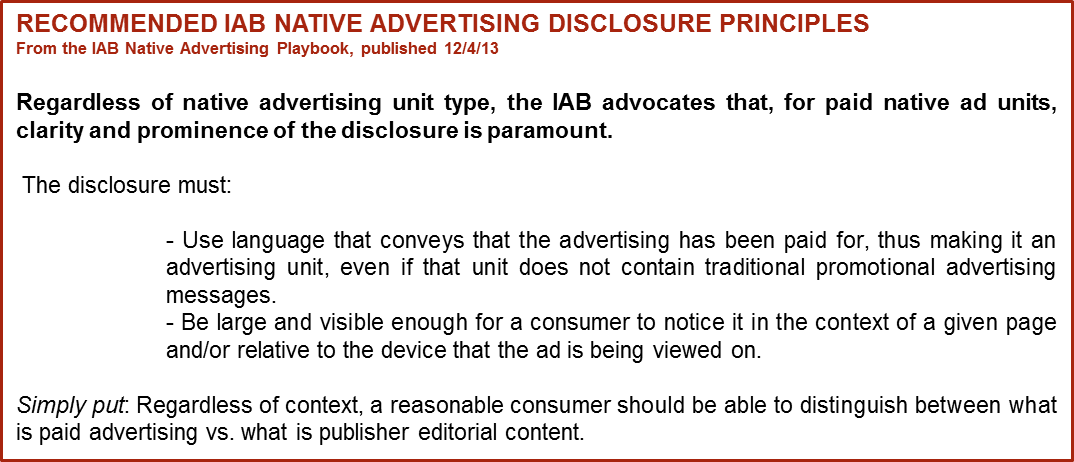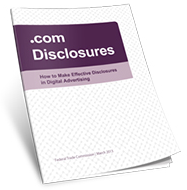We start the New Year by addressing a question that’s on many people’s minds in the digital industry…
Will the FTC provide guidance on native advertising in 2015 and, if so, what might we expect?
 At December’s IAB Native Advertising Disclosure Workshop, which was attended by Laura Sullivan, Senior Staff Attorney, Division of Advertising Practices at the Federal Trade Commission, along with nearly 200 IAB event registrants, there was some speculation that the FTC had plans to provide guidance for native advertising.
At December’s IAB Native Advertising Disclosure Workshop, which was attended by Laura Sullivan, Senior Staff Attorney, Division of Advertising Practices at the Federal Trade Commission, along with nearly 200 IAB event registrants, there was some speculation that the FTC had plans to provide guidance for native advertising.
I sat down with Mike Zaneis, Executive Vice President, Public Policy & General Counsel from the IAB’s Washington, DC, office to get some perspective on what FTC guidance for native advertising might entail.
When the FTC provides “guidance” on a specific advertising topic, what does that mean? Why do they do this?
Companies may be familiar with legal regulations that have been promulgated by the FTC, such as those issued last year under the COPPA statute. These regulations have the force of law and must be followed by companies. The FTC also brings enforcement cases against “unfair or deceptive” business practices. Because this authority is extremely broad, the FTC sometimes helps companies understand what may be expected of them by issuing formal guidance. These documents provide examples of good or bad business practices and may provide direction in new or emerging marketplaces.
Although it is speculative at this point in time, what might we expect from guidance on native advertising disclosure?
In the past, the FTC has issued broad-based guidance as well as guidance for specific business models. In the native advertising space they have only delved into the search advertising space, issuing guidance in 2002 and then providing an update in June of 2014. It is hard to predict what type of guidance they may issue in the future, but the focus on multiple business models during their 2013 native advertising townhall is a clear indication of the scope of their interest.
The IAB, via its Native Advertising Task Force, issued the Recommended Native Advertising Disclosure Principles below as part of its Native Advertising Playbook (published 12/13). How similar or different might the FTC’s guidance look?

The IAB disclosure principles are a good example of the broad-based guidance that I described above. At their core they simply attempt to apply the existing law around advertising disclosures to the emerging field of native advertising. In this case we might expect similarly broad language from the FTC, accompanied by specific examples in several native advertising categories such as In-Feed and Recommendation Widgets as outlined in the IAB Native Advertising Playbook. This was how they developed their “.com Disclosures” guidelines in the past.

FTC.com Disclosure document. Source: FTC
Do you have any suggestions on what, if anything, publishers/marketers/agencies could or should do in anticipation of potential guidance being issued for native advertising?
As an industry we should strive to be proactive versus reactive in this area. At the IAB’s recent native advertising townhall event we heard from more than a dozen companies about how they are evolving their disclosure practices. These developments ensure that consumers understand where the content on the page ends and the advertisement begins. Many of us long assumed that disclosure and consumer engagement were countervailing forces, but we are discovering that, to the contrary, an informed consumer is a happy, engaged consumer.
How does the FTC announce that they are providing formal guidance?
There is no set process for issuing guides. In the ideal scenario they will publish a draft and solicit public comment before finalizing the document. However, they have sometimes simply issued new guides without a comment period or, in the case of search advertising, just sent letters to a number of companies to provide details on the updated guide.
If guidance is issued, how should publishers/marketers/agencies respond?
While they do not carry the same legal weight as a regulation, guides provide insight into the types of areas where the FTC maybring future enforcement actions. Therefore, companies should pay close attention to the “advice” provided in these documents and double check their current business practices against them. Guidelines are usually just that, guidelines, and they should provide room for variation, responsible experimentation, and future innovation.
For those who had questions about potential FTC Native Advertising Disclosure Guidance, we hope these answers were helpful. The IAB will continue to advocate that disclosure is of paramount importance for this growing source of digital advertising revenue. We will continue to provide updates on potential FTC guidance as/if available.




